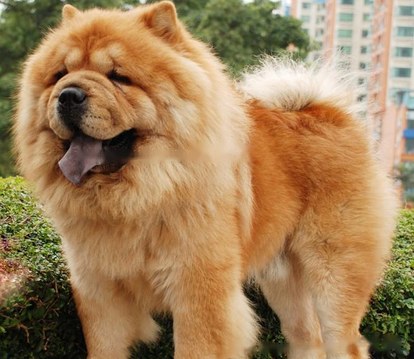The AKC officially recognized the breed in 1903, and in 1906 the Chow ChowChow Club of America was approved Agreed to form and serve as one of the AKC's member clubs, and today it's a fairly established breed in America.

Overall Proportion:
Today's large head compared to the body was less pronounced in the 1820s. At that time, fox-like faces and narrow skulls were very common, especially in bitches. Skull: Description of the skull in the standard: Skull flat, broad, with a small turn, well expanded and enlarged below the eyes. That is, when you stroke the skull, it should be as flat as possible. For a better understanding, take a ruler and place it behind the ear and under the crease of the eye, along the muzzle. The muzzle should be almost in line with only a small gap under the ruler. It is very flat in both vertical and horizontal directions between the eyes and ears. So-called round heads were very common after the First World War. This word is used to describe the occipital portion (the skull behind the ears) that is round. This is a very serious flaw because there shouldn't be any curves at all at the top of the skull. Due to hair growth, the head appears to have more prominent protrusions than the standard description, but close inspection confirms that there should be no such protrusions
The location of the ears:
The Chow Chow's ears are a distinguishing feature, and many good Chow Chow are downgraded because of their oversized ears or the height of the ears. If one of your puppy's ears is larger than you expect, don't be surprised that your first impression is that both ears are too large and set too high. Then the ears will be more closed and less erect. It is difficult to describe the correct part of the ear root in words. Perhaps the ideal position is when the inside of the ear is exactly in line with the inside of the eye, which also reiterates the importance of a wide muzzle (similar to the width of the eyes). It's hard to see thin ears these days, those that look and feel thin. In some bloodlines, especially deep reds, the ears are often small and ideally placed, but the lack of rich hair makes them more perfect.
The angle of the neck:
There is always someone who prefers a longer neck. Quote standard Neck is full and strong, well connected to the shoulders, slightly arched. Length is not mentioned here. The word full here means that the circumference of the neck is only slightly smaller than the skull. Because of the rich coat and mane, the neck of the Chow Chow is somewhat short, forming a harmonious whole with the body of the dog. For those who love long necks, don't realize that a long neck often means a longer back (the two always go together, as it has been well documented). The connection of the neck to the body is very important as it disrupts or enhances the overall balance of the Chow Chow. The connection of the neck to the body must not appear to be plugged in or give a feeling of instability.
Characteristics of the head:
The head of the Chow Chow is the most characteristic and cannot be compared with other breeds. Any judge would consider the peculiar expression of the Chow Chow to be a distinct feature that distinguishes it from other breeds of the Fox Dog. One might say that the position of the eyes is also quite important. The standard describes eyes, dark, small, almond shaped (fawn, cheese, light blue acceptable). Dark, so dark? Pure black or hazel. Small, so small? I think the very black eyes on the red undertone spoil the facial expression. While the black chow generally tends to have very dark eyes, this is not to say that dark hazel is not allowed, there are many black champion dogs with such eyes. Light-colored eyes are undesirable on a black Chow Chow under any circumstances. We all agree that the eyes should be almond shaped, sometimes called triangular eyes. But what is small, and how small is small? A very small eye on a very large skull may seem odd, but round eyes are definitely not desirable.
![[Dog Training 5] The training method of pet dog dining etiquette](/static/img/12192/12192_1.jpg)




